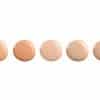- Key Points
- What Is a Skin Type?
- What Are the Most Common Skin Types?
- What Is a Normal Skin Type?
- What Is Oily Skin Type?
- What Is Combination Skin?
- What Is Sensitive Skin?
- Is There a Difference Between Sensitive and Sensitized Skin?
- Which Skin Type Is Perfect?
- How Do Lifestyle Habits Affect Your Skin?
- How To Know Your Skin Type
- Skin Type Test
- Tame Your Skin With Confidence!
Key Points
-
Learning your skin type facilitates a proper skincare routine with the most suitable products for your face.
-
Your genetics determine your skin type, but it may change over the years, depending on a variety of factors.
-
Common skin types include sensitive, dry, oily, and combination skin.
Is all skin created equal? If you think all skin is the same, think again. Just like there are several body types, there are many skin types, too. Knowing your skin type and how it changes gives you the power to make the best decisions for your skin's sake.
You can't take charge of your skin without knowing your skin type. Creating a skincare routine with no prior knowledge of your skin type won't result in healthy or happy skin. It puts your epidermis at a higher risk of irritation and damage. Getting to know your skin comes in handy to select elite ingredients, products, and skincare practices suitable for your skin type.
Learning your skin type provides you with the confidence to dismiss others' opinions of what you should put on your skin. Your skin type is unique. No matter how much people hype or endorse a skincare product, it doesn't mean it's compatible with your skin.
What Is a Skin Type?
The first step of skincare is knowing your skin type. Treating the skin without knowing your skin type is like treating a patient without a diagnosis. You need to know what your skin is before you coat it with skincare products.
Dr. Shereene Idriss, a YouTube famous dermatologist based in New York City, says, "Your skin type is what you are inherently predisposed to, what your genetics dictate, what you were kind of predestined to have when you were born."
What Are the Most Common Skin Types?
The most common skin types are dry, oily, combination, and sensitive.
Some people also have a combination of these skin types. For example, some have dry, sensitive skin and others have oily, sensitive skin. The sensitivity levels also vary; some sensitive skin is more severe than others.
Skincare brands use these basic skin type terms to better market their products to consumers. Skin experts don't use these skin type classifications to determine your skin type. Dermatologists approach skin types using the Fitzpatrick Scale.
In her YouTube channel, Houston-based dermatologist Dr. Andrea Suarez says, "[T]he Fitzpatrick phototype […] helps in determining how an individual skin is going to respond basically to light."
With this skin type scale, skin experts determine how susceptible your skin is to burning and tanning after sun exposure based on the amount of melanin in the skin. The Fitzpatrick chart includes six skin types.
What Is a Normal Skin Type?
The "normal" in “normal skin type" is problematic. Everyone's definition of normal is different. Plus, the negative connotation it carries makes it seem like the "perfect" or "standard" skin type that everyone should aspire to have.
It also suggests that those without “normal” skin have abnormal skin, which is NOT true! The other skin types are not abnormal; they're actually common. It's time to kick "normal" out of the skincare dictionary and replace it with another word. Dr. Shereene Idriss suggests a better phrase for normal skin is moderate skin.
It's easy to be jealous of those with a moderate skin type; they're considered lucky because their skin is neither too dry nor too oily. This skin type is rare. They have well-balanced skin with few or zero imperfections. It typically looks smooth and doesn't have many blemishes. Its pores are almost hard to see, and it's not prone to severe sensitivity.
No hate for those who have balanced complexions, but don't brag about it, please!
What Is Oily Skin Type?
People with oily skin types produce too much sebum, which makes the skin feel greasy and sticky. The skin may also look shiny like golden ornaments on a Christmas tree.
The overproduction of oil makes people with oily skin more prone to acne. The excess sebum can clog your pores, making them look larger.
Having oily skin doesn't mean you automatically develop acne, but failing to control excess oil on the skin increases your chances of pores getting clogged and forming an acne-ridden complexion.
Before cursing at the skin gods for giving you oily skin, know that all skin types can develop acne. You are not alone in your acne struggles.
The gods of modern skincare provide many lightweight and oil-free products to keep glossy skin at bay.
What Is Combination Skin?
Many consider combination skin as the most common skin type. People with combination skin may have a mix of dry and oily or normal and oily features. Some people with this skin type may have dry cheeks and an oily T-zone (forehead, nose, chin). Some areas of their skin may look shiny and their pores appear enlarged.
The major con about having combination skin is potentially having to spend more on skincare products. People with combination skin might have to purchase different products for specific areas of their face. Controlling combination skin takes a lot of work but is manageable with the proper skincare products and habits.
What Is Sensitive Skin?
Sensitive skin, also known as reactive skin, easily responds when it comes in contact with something like skincare products. Sensitive skin sometimes looks itchy and red. It might also burn and sting. People with sensitive skin tend to also have dry skin and certain skin conditions.
People who are sensitive to touch need to be extra picky when choosing their skincare products. The fewer skincare products, the better. Applying too many skincare products easily irritates sensitive skin.
Is There a Difference Between Sensitive and Sensitized Skin?
There is a difference between sensitive skin and sensitized skin. Sensitized skin is a skin condition – not a skin type. Sensitized skin occurs when your skin becomes sensitive or reactive to something, like skincare products or environmental stressors. When you overuse products, your skin may develop an allergy to their ingredients, sensitizing your skin to those products.
Which Skin Type Is Perfect?
Wondering whether there is a "perfect" skin type is a huge waste of time. There is no such thing as a "perfect" skin type. Everyone is born with one-of-a-kind skin determined by genetics. People’s skin types also change depending on the season, environment, diet, weather, hormonal fluctuation, aging, and lifestyle habits.
Some people think normal skin is perfect because it's a well-balanced skin type. Calling a normal skin type "perfect" is problematic because it causes people to aspire to a normal skin type.
While many factors cause skin changes, it's not easy to fully change the skin type you're born with. You may detest your genetically predisposed skin type, but you can manage it so it doesn't get too out of control.
Some people hate their oily skin and wish for a normal skin type, but having normal skin isn't always better or desirable. Indian cosmetic dermatologist Dr. Rasya Dixit says, "People who have normal to dry skin […] get wrinkles faster; they age faster. Oily skin actually ages slower."
In short, all skin types have pros and cons, and some are more challenging to manage than others.
How Do Lifestyle Habits Affect Your Skin?
Drinking, smoking, and not bothering to put on sunscreen or follow a proper skincare routine negatively impact your skin's health. Poor sleeping habits and feeling stressed also take a toll on your skin.
Picking at your face or pimples, over-cleansing, over-exfoliating, using too many skincare products, and going to bed with makeup on gives way to annoying skin issues. Even taking certain medications can cause skin changes.
How To Know Your Skin Type
Although scheduling a dermatology visit is highly recommended, going to a dermatologist is not essential to determine your skin type. No one knows your skin better than you.
How does your skin feel when you wake up? What changes does your skin experience under certain weather conditions or environments? Does your skin break out after eating certain foods? Only you know the answer to these questions and a dermatologist can explain why these changes occur.
Have the confidence to determine your skin type without stressing out.
Skin Type Test
Performing a skin type test at home is a quick and easy way to discover if your skin is oily, dry, balanced, or another type.
Wash Your Face and Wait
Before doing a skin type test at home, remove all your makeup with micellar water or makeup remover. Next, wash your face with a gentle cleanser and gently pat it dry.
Then leave your face alone for at least 30 minutes or up to two hours. During this time, don't touch your skin, and don't apply any cosmetic or skincare products to your face. Avoid going outside while you wait to prevent sun damage.
After the wait time is over, stand in front of the mirror and notice how your skin looks and feels.
You have dry skin if your entire face feels dry and tight immediately after cleansing. It may look dull, cracked, and feel rough after a couple of hours. You have oily skin if your whole face is oily and shiny.
If your T-zone is oily and your cheeks or outer parts of your face are dry and tight, you have combination skin. Red and itchy skin after cleansing means you likely have sensitive skin. Sensitive skin types also tend to be on the drier side.
Kudos if your skin is not tight or greasy; it means you have normal/balanced skin.
How To Know Your Skin Type Using Tissue or Blotting Paper
A simple way to learn your skin type is by dabbing your face with a thin tissue or blotting paper. It's preferable to use blotting papers as they absorb the excess oil on the surface of your face, making it easy to identify oily skin.
First, make sure your face is clean by washing it with a gentle cleanser. Next, wait anywhere from 30 minutes to two hours. Once time is up, dab tissues or blotting paper on different parts of your face. Make sure to use a new tissue or blotting paper every time you test a different area of your face. Don't rub your skin with tissue or blotting paper.
Look at the tissues/blotting papers to see which areas of your face are oily. If all the tissues have a lot of traces of oil, you likely have oily skin. If the tissues stick to your face, you have oily skin. If some tissues look clean and some look oily, you have combination skin. You also have combo skin if they stick to your T-zone and the ones on the outer edges of your face fall off.
Your skin is dry if the blotting papers have little to no traces of oil or easily fall off your face.
If the blotting papers are not excessively oily and stick onto your face but eventually fall off, you probably have normal skin. If the skin becomes irritated after using the blotting paper or tissue, it's a sign your skin is highly reactive.
Look at Your Pores
If you're not 100 percent sure you identified your skin type correctly with the blotting paper, looking at the size of your pores may help clear up your doubts. Stand close to the mirror to examine your pore size. If your pores are large and visible, you probably have oily skin. Your skin might be dry or normal if your pores are small and barely visible.
Tame Your Skin With Confidence!
Feeling frustrated with your skin type? Embrace your skin and accept that it may change over time or under certain conditions. Loving your natural skin type does not mean neglecting it. Take care of your skin to avoid infuriating skin issues.
The skincare market is overflowing with skincare products designed for every skin type, guaranteeing happy, healthy, skin. Choosing the right products to care for your skin is challenging, but knowing your skin type and skin conditions makes the product-hunting process less overwhelming.










